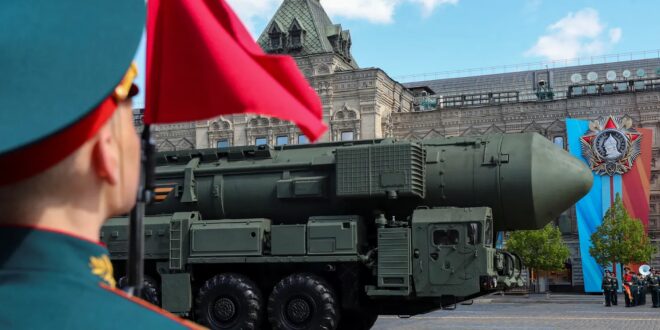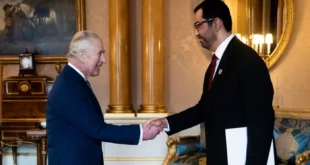How to Save the Norms Against Testing, Building, and Using the Ultimate Weapon
The risk of nuclear war is the highest it has been since the end of the Cold War. The cause lies primarily with Russia’s ongoing nuclear threats and drills amid the conflict in Ukraine, but not with Russia alone. Tensions in the Middle East may spur Iran to speed up its suspected pursuit of a nuclear weapons program. North Korea continues to modernize and expand its nuclear arsenal. And if Donald Trump wins a second term, the United States could return to nuclear testing as well, as Trump’s former national security adviser Robert O’Brien suggested in Foreign Affairs this summer.
Together, these developments represent a challenge to the institutions, rules, and taboos that have prevented the use of nuclear weapons since the bombing of Hiroshima and Nagasaki in 1945. But the erosion of this nuclear order is not happening in isolation. Autocratic leaders––primarily in China, Iran, North Korea, and Russia––often work in concert as part of a quest to undermine the existing international order, challenging norms related to human rights, international borders, and, increasingly, nuclear weapons. Despite the success of global diplomatic efforts to establish norms around the use of nuclear weapons, the world can no longer assume that nuclear weapons will not be used in a conventional conflict.
NUCLEAR BREAKDOWN
Norms are essentially rules of the road. They can be embodied by institutions, such as the 1968 Nuclear Nonproliferation Treaty (NPT) and the 1997 Comprehensive Nuclear Test Ban Treaty (CTBT) in the case of nuclear weapons. But as a “standard of appropriate behavior,” norms are not always concrete. In the nuclear order, norms can prevent states from using nuclear weapons through constraining mechanisms; the so-called nuclear taboo relies on the widespread moral and political rejection of nuclear weapons to discourage their use. Norms can also compel states to abide by their treaty commitments through prescriptive mechanisms.
By now, most states have pledged to not build or test nuclear weapons. Norms against nuclear use, proliferation, and testing are well established but have been historically contested, especially the norm against nuclear testing. In a recent study, we found that these norms, which have been firmly in place since the mid-twentieth century, are increasingly being challenged by a handful of actors. One particular vulnerability is the norms’ interconnectedness: if one norm, such as that against nuclear testing, is violated, then other norms, including nonuse and nonproliferation, could also become threatened. Thus, a rejection of one nuclear norm might spur a rejection of the entire nuclear order.
In the worsening security environment of recent years, international leaders and nuclear experts have suggested that all three norms could be further challenged. In October 2022, the U.S. intelligence community estimated that the risk of nuclear use in Ukraine could rise to 50 percent—effectively a coin flip. Robert Floyd, the executive secretary of the CTBT, stated that “progress risks unravelling absent a legally binding ban on nuclear testing.” Although the majority of states (187) are signatories to the CTBT and observe the norm against nuclear testing, the treaty has yet to enter into force because some nuclear-capable states have not yet ratified it over strategic and technological concerns, including fears that verifying compliance will be difficult and that some signatories might not abide by the terms of the treaty.
If nuclear norms continue to break down, the world might become a much more dangerous place. More frequent nuclear testing, for example, could have devastating humanitarian and environmental results. For a glimpse of such effects, recall that an American test in 1954 of a high-yield nuclear weapon on Bikini Atoll in the Marshall Islands vaporized three islands, contaminated 15 more, and caused the development of thyroid tumors among the population. Amid a growing number of regional conflicts, the consequences of a world with no nuclear taboo and no norm against the use of nuclear weapons could be even more catastrophic.
WORKING IN CONCERT
The widening array of actors contesting the international order makes the preservation of norms around nuclear weapons all the more important. Since 2014, Chinese President Xi Jinping has insisted that China under his leadership is competing for the future of the international order, challenging the alliances, institutions, and principles that the United States has long relied on to shape the international system. A decade ago, Russian President Vladimir Putin also called for a new world order more aligned with Russia’s interests. In August 2024, he signed a decree to “provide assistance to any foreigners who want to escape the neoliberal ideals being put forward in their countries and move to Russia.” China, Iran, North Korea, and Russia are increasingly enabling one another in an “axis of upheaval,” as Andrea Kendall-Taylor and Richard Fontaine argued in Foreign Affairs, whereby “the growing cooperation among [the four countries] is fueled by their shared opposition to the Western-dominated global order, an antagonism rooted in their belief that that system does not accord them the status or freedom of action they deserve.”
These four powers are bent on contesting all three major nuclear norms. They rely on nuclear weapons—and the specter of those weapons—to achieve their regional and strategic aims. And all are willing to undermine the nuclear order to do so. Russia and North Korea have both threatened to use nuclear weapons in recent years. Putin stated in February 2024 that Western nations “must realize that we [Russia] also have weapons that can hit targets on their territory.” North Korean leader Kim Jong Un has also repeatedly threatened to use nuclear weapons preemptively. China is rapidly expanding its nuclear arsenal while opposing arms control talks. Iran has contested the norm against nuclear proliferation, developing key components for a nuclear weapons program that belies Tehran’s claims of peaceful intentions and that has been harder to curb since the United States’ withdrawal in 2018 from the nuclear deal that aimed at limiting Iran’s weapons program in exchange for sanctions relief. North Korea also rejected curbs against proliferation through its withdrawal from the NPT in 2003 and its subsequent development of nuclear weapons and missile technology, its nuclear tests, and its defiance of international sanctions.
Countries are most concertedly challenging the norm against nuclear testing, the weakest of all the nuclear norms. The most blatant recent violation of the three norms occurred with North Korea’s 2017 test of what is suspected to have been a thermonuclear weapon. Less blatant but still relevant are its ongoing threats to test again. These actions have not only showcased advancements in North Korea’s nuclear capabilities but also challenged the global consensus against nuclear testing. Russia has indicated a willingness to resume nuclear testing amid heightened geopolitical tensions. A resumption of nuclear testing, particularly by a state other than North Korea, which is widely regarded as a pariah, would undermine the norm and raise concerns about a new arms race. And all this nuclear saber rattling increases the risk of a conventional war flaring into a nuclear conflict.
It is worth noting that authoritarians are not the only ones who have challenged nuclear norms. The United States broke with global norms when it failed to ratify the CTBT in 1999, as did South Korean political advisers when they suggested that South Korea develop an independent nuclear weapons program.
ON THE BRINK
The nuclear order is in danger, and no country can uphold it alone. The United States should therefore prioritize two sets of international partnerships that could enforce nuclear norms in this interconnected environment. First, Washington must expand its relationships with countries in the global South, many of whom would be ready partners to challenge intransigence and norm contestation. Indeed, countries such as Mexico have voiced concerns about the recent erosion of the nuclear order, including the risks of nuclear use and the increasing salience of nuclear weapons. Both Xi and Indian Prime Minister Narendra Modi have sought to constrain Putin, reminding the Russian president that the use of nuclear weapons in the war in Ukraine would be unacceptable.
The threats to the nuclear order offer an opportunity for consensus building. Countries should pursue more regional engagement and dialogue and develop better understandings of different perspectives on nuclear weapons. Nuclear-armed states, for instance, view nuclear weapons as essential for their own security, but many states that do not have these weapons see them as fundamental threats to global peace, advocating instead for total disarmament. Building consensus might require uncomfortable conversations about concerns that the United States is not fulfilling its own responsibilities to the nuclear order—it is among a handful of states that have signed the CTBT but have failed to ratify the treaty. Nevertheless, one goal of these dialogues should be to demonstrate that not all the states that possess nuclear weapons are alike, and they should not be treated as a monolith in international diplomacy. Many nonnuclear states blame all nuclear possessors equally for the erosion of nuclear norms without calling attention to the riskiest behaviors, such as Russia’s nuclear saber rattling in Ukraine. Dealing with nuclear states individually can help isolate responsible behaviors from irresponsible behaviors and tailor pressure on those states actively resisting the nuclear order.
A second priority should be to reinforce partnerships with U.S. allies in NATO and in the Indo-Pacific to uphold existing nuclear norms. A particular challenge, however, will be that steps to strengthen one norm could indirectly weaken others. For example, a nuclear deterrent against escalation might strengthen the norms of nonuse and nonproliferation because increased security would decrease the need for nonnuclear powers to develop independent nuclear capabilities. At the same time, it could present obstacles for long-term arms control and disarmament by increasing the salience and perceived value of nuclear weapons. For this reason, the United States and its partners should embrace a dual-track approach, supporting deterrence––such as through recent statements by Biden administration officials indicating that the United States may have to expand its nuclear modernization plans––while also exploring creative solutions for nuclear risk reduction and norm strengthening. For instance, the United States could encourage Japan—the only country to have experienced the devastation of nuclear weapons in war—to facilitate dialogue between nuclear-armed states and nonnuclear states in the interest of norm preservation.
The United States must continue to invest in its alliances, extend its commitment to deterrence, and engage in honest dialogue with both nuclear and nonnuclear states, making clear the stakes if the current slide continues. The nuclear order is quietly breaking down, and a breach in just one of its pillars could catastrophically undermine them all.
 Eurasia Press & News
Eurasia Press & News



